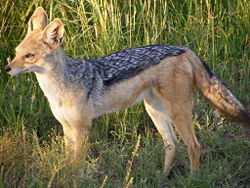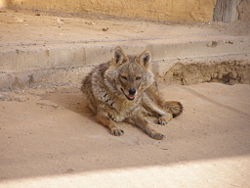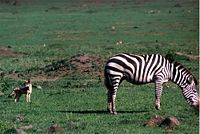Jackal
- This article is about the animal. For other meanings, see jackal (disambiguation).
| Jackal | ||||||||||||
|---|---|---|---|---|---|---|---|---|---|---|---|---|
 A black-backed jackal in Masaai Mara
| ||||||||||||
| Scientific classification | ||||||||||||
| ||||||||||||
| File:Jackals.png | ||||||||||||
|
Canis aureus Canis adustus Canis mesomelas |
A jackal (from Turkish çakal, via Persian shaghal ultimately from Sanskrit sṛgālaḥ [1][2]) is a member of any of three (sometimes four) small to medium-sized species of the family Canidae, found in Africa, Asia and southeastern Europe.[3] Jackals fill a similar ecological niche to the coyote in North America, that of predators of small to medium-sized animals, scavengers, and omnivores. Their long legs and curved canine teeth are adapted for hunting small mammals, birds and reptiles. Big feet and fused leg bones give them a long-distance runner's physique, capable of maintaining speeds of 16km/h (10mph) (just over 6 min/mile) for extended periods of time. They are nocturnal, most active at dawn and dusk.
In jackal society the social unit is that of a monogamous pair which defends its territory from other pairs. These territories are defended by vigorously chasing intruding rivals and marking landmarks around the territory with urine and feces. The territory may be large enough to hold some young adults who stay with their parents until they establish their own territory. Jackals may occasionally assemble in small packs, for example to scavenge a carcass, but normally hunt alone or as a pair.
Use in slang
All species of jackal are capable predators (all three hunt rodents and small mammals regularly, with the golden and black-backed species known to hunt poisonous snakes, large ground birds such as bustards, and mammals as large as young antelope). However, their popular image as scavengers has resulted in a negative public image.
- The expression "jackalling" is sometimes used to describe the work done by a subordinate in order to save the time of a superior. (For example, a junior lawyer may peruse large quantities of material on behalf of a barrister.) This came from the tradition that the jackal will sometimes lead a lion to its prey. In other languages, the same word is sometimes used to describe the behavior of persons who try to scavenge scraps from the misfortunes of others; for example, by looting a village from which its inhabitants have fled because of a disaster.
- In Nonviolent Communication, "jackal language" refers to communication that labels, judges, and criticizes.
ReferencesISBN links support NWE through referral fees
- The New Encyclopedia of Mammals edited by David Macdonald, Oxford University Press, 2001; ISBN 0-19-850823-9
- Cry of the Kalahari, by Mark and Delia Owens, Mariner Books, 1992.
- The Velvet Claw: A Natural History of the Carnivores, by David MacDonald, BBC Books, 1992.
- Foxes, Wolves, and Wild Dogs of the World, by David Alderton, Facts on File, 2004.
See also
- Bardi - shapechanging spirit in Trebizond folklore (feminine jackal)
- Anubis - Egyptian god with the head of a jackal
External links
Footnotes
- ↑ American Heritage Dictionary - Jackal entry
- ↑ Online Etymology Dictionary - Jackal entry
- ↑ Ivory, A. 1999. "Canis aureus" (On-line), Animal Diversity Web. Accessed January 18, 2007 at http://animaldiversity.ummz.umich.edu/site/accounts/information/Canis_aureus.html.
Credits
New World Encyclopedia writers and editors rewrote and completed the Wikipedia article in accordance with New World Encyclopedia standards. This article abides by terms of the Creative Commons CC-by-sa 3.0 License (CC-by-sa), which may be used and disseminated with proper attribution. Credit is due under the terms of this license that can reference both the New World Encyclopedia contributors and the selfless volunteer contributors of the Wikimedia Foundation. To cite this article click here for a list of acceptable citing formats.The history of earlier contributions by wikipedians is accessible to researchers here:
The history of this article since it was imported to New World Encyclopedia:
Note: Some restrictions may apply to use of individual images which are separately licensed.

